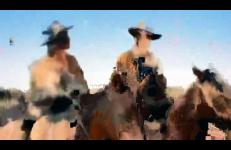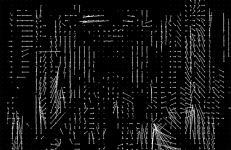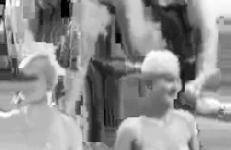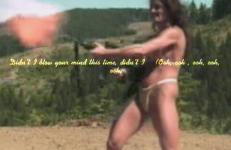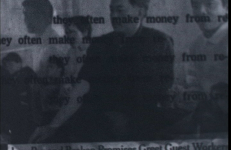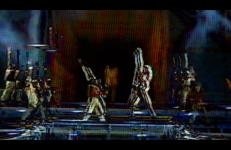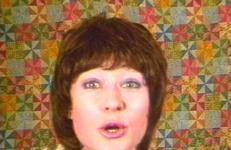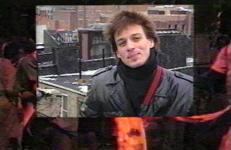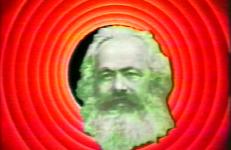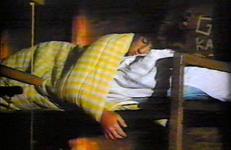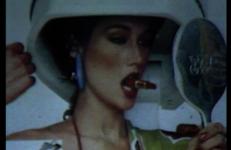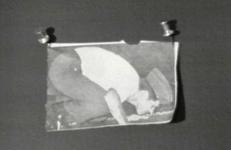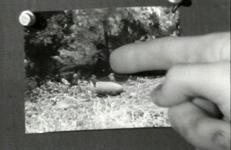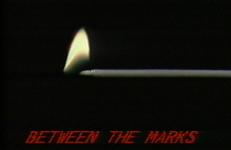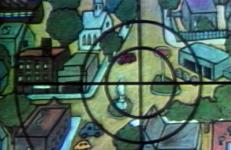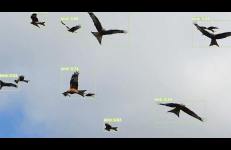Removing keyframes from a digital version of John Ford's The Searchers, Baron and Goodwin attack the film's temporal structuring to render a kinetic “painted desert” of the West. The dust kicked up by the movement in the film is pure pixel, unanchored from the photographic realism that used to constrain it.
Media Analysis
Derived from Ernie Gehr's Serene Velocity, Lossless #4 is the result of a digital file's debugging routine that reveals vectors describing apparent movement in the frame. Having removed the picture, thereby isolating these vectors, the formal qualities of Gehr's film are detectable. The hypnotic effects of the shifts in the lens’s focal length in the original are now substituted with a purely graphical representation, creating a perverse replacement of the optical effect of the original.
Derived from Ernie Gehr's Serene Velocity, Lossless #4 is the result of a digital file's debugging routine that reveals vectors describing apparent movement in the frame. Having removed the picture, thereby isolating these vectors, the formal qualities of Gehr's film are detectable. The hypnotic effects of the shifts in the lens’s focal length in the original are now substituted with a purely graphical representation, creating a perverse replacement of the optical effect of the original.
In Lossless #5, a water-ballet crafted by the famed Busby Berkley is compressed into an organic mitosis, within which we detect the spirit of a "buggy" Brakhage ghosting about the integrated circuit.
In Lossless #5, a water-ballet crafted by the famed Busby Berkley is compressed into an organic mitosis, within which we detect the spirit of a "buggy" Brakhage ghosting about the integrated circuit.
Love Songs #1 is composed of three pieces that pose questions about urban culture, race, and politics. Found footage images are manipulated and juxtaposed with popular music; the effects are unsettling, ironic, and sometimes humorous.
This film was made from The New York Times newspaper articles. The semi-automated animation process resulted in sentence recombinations that sometimes made sense while randomly emphasizing certain words and images.
The computer animation was transferred to one 100ft roll of 16mm Tri-X reversal film and then hand-processed. The reversal negative is the original.
Producer/ Director: Sabine Gruffat
Hand Processing: Matthew Kelson
In the film Mad Ladders, the prophetic ramblings of an unseen narrator recount fantastical dreams of the coming Rapture, as crystalline imagery of rolling clouds gives way to heavily-processed video of moving stage sets from The American Music Awards telecasts of the 1980s and early 1990s. Blooming and pulsing in and out of geometric abstraction, this swirling storm of rising curtains, spinning set pieces, and unveiled pop idols forms an occult spectacle, driven by its impassioned narrator and an 8-bit leitmotif.
Combining Rubnitz’s skillful manipulation of the familiar “look” of TV shows with an extraordinary range of characters, performer Ann Magnuson convincingly impersonates the array of female types seen on TV in a typical broadcast day. From glitzy to drab, from friendly housewife to desperate evangelist, Magnuson is a one-woman universe appearing on every channel, the star of every program—giving her all as the chameleon woman who is always on display.
Combining Rubnitz’s skillful manipulation of the familiar “look” of TV shows with an extraordinary range of characters, performer Ann Magnuson convincingly impersonates the array of female types seen on TV in a typical broadcast day. From glitzy to drab, from friendly housewife to desperate evangelist, Magnuson is a one-woman universe appearing on every channel, the star of every program—giving her all as the chameleon woman who is always on display.
Revolving around a movie mogul’s familial intrigues, Made In Hollywood tells the story of two artists selling out to make movies, and a simple country girl’s angelic rise to fame despite it all. As a copy of a copy, this tape critiques what it mimics, and, by revelling in the glitz and glamour of image-obsessed stars, exploits the love/hate relationship viewers have with their media icons: simultaneously viewing them as perfect models and ridiculous trumped-up figures existing only in the fantasy-land that is Hollywood.
Revolving around a movie mogul’s familial intrigues, Made In Hollywood tells the story of two artists selling out to make movies, and a simple country girl’s angelic rise to fame despite it all. As a copy of a copy, this tape critiques what it mimics, and, by revelling in the glitz and glamour of image-obsessed stars, exploits the love/hate relationship viewers have with their media icons: simultaneously viewing them as perfect models and ridiculous trumped-up figures existing only in the fantasy-land that is Hollywood.
Magic for Beginners examines the mythologies found in fan culture, from longing to obsession to psychic connections. The need for such connections (whether real or imaginary) as well as the need for an emotional release that only fantasy can deliver is explored.
"Out of the blue, I bought my first television. I kept the TV on all the time."
— Andy Warhol
After an all-night session of editing Free Society, Garrin headed home with video-8 camera in-hand, only to happen upon the Tompkins Square riots. As police tried to enforce a curfew aimed at removing homeless people from the park, Garrin began gathering footage of cops beating up protesters. He was then attacked by police himself, as the camera continued to roll. The footage was subsequently incorporated into Free Society, in which the military myth of "protect and serve" is dismantled by first-hand experience.
Displaying a broad range of Golden Age Hollywood animation, Manifestoon is an homage to the latent subversiveness of cartoons. Though U.S. cartoons are usually thought of as conveyors of capitalist ideologies of consumerism and individualism, Drew observes: "Somehow as an avid childhood fan of cartoons, these ideas were secondary to a more important lesson—that of the 'trickster' nature of many characters as they mocked, outwitted and defeated their more powerful adversaries.
Meatballs - (Bill Murray + leading cast) = Marbles. A Hollywood classic re-visited and re-edited until our hero is no longer in sight.
This title is also available on Animal Charm Videoworks: Volume 2, Hot Mirror Mix.
An electronic disturbance created during a live audio meltdown by Animal Charm as part of their Hot Mirror Mix in the fall of 1998.
This title is also available on Animal Charm Videoworks: Volume 2, Hot Mirror Mix.
A live performance on a public-access cable program in New York deconstructing the messages in Vogue and its advertising. The work looks at the institutional slants of the magazine industry and the fashion industry’s reliance on sweatshops.
Baldessari asks Ed Henderson to discuss the meaning of selected news photos. Henderson invents the conditions of the where, when, and why each was taken—and decides whether the photo was altered in any way. This exercise complicates the reception of news media images and encourages a more analytical attitude towards the implicit meaning, and potentially faked reality, of such images.
This title was in the original Castelli-Sonnabend video art collection.
Baldessari presents photographs to his friend Ed Henderson and asks him to reconstruct the meaning of the image. In each case, Baldessari's strategy is to appropriate an existing image and remove it from its context in order to deconstruct the process of interpretation, and call the supposed objectivity of interpretation into question. The tape implicates the viewer in Ed Henderson's groundless exegesis, as he hypothesizes about the meaning of several photographs, speculating on their actual or staged reality.
A series of three videotape fragments (Fuse, Timer, Slow Down) presented as visual commentaries on television ads, these pieces are critical responses to the visual speed, narrative style, and format used in the making and delivering of the moving images. People producing images have been forced (for personal and public reasons) to speed up timing—time is money. This is how society builds its own schemes, structures, and culture, and how it represents them; we are consuming images as we consume food, gas, and ideas.
A video poem about the nature of social relations and mass media, Half Lies exposes the seemingly innocuous ways we distort truth. Harmonious families, trade treaties, and current events are among the mediated realities that Cuevas interrogates. Half Lies makes the viewer question the half truths we encounter daily. The video walks the haunting gray area between documentary and drama, creating a world that is both shockingly grotesque and startingly authentic.
Functioning as both a fake documentary and a fake advertisement, Meet the People deals with issues of desire, complicity, and identity in the age of mass media, as 14 “characters” talk about their lives, desires, and dreams.
Mike Builds a Shelter is a performance comedy with apocalyptic overtones, a narrative extension of Smith's installation Government Approved Home Fallout Shelter/Snack Bar. In this darkly humorous morality play, Smith contrasts Mike's rural adventures in a pastoral landscape with his home fallout shelter. Throughout, the dual narratives are intercut with episodes of Mike's Show on cable, in which Mike's banal domestic activities are eagerly if passively received by living-room TV viewers.
Intertwining associated experiments in image and sound generation using AI, Nearest Neighbor focuses on language acquisition and mimicry between humans, birds and machines, asking fundamental questions about consciousness, learning and understanding. The film is a contemporary reflection on the state of technology in relation to the natural world. It asks us to think about what we want from inter-species communication and what we expect from technologies that aspire to substitute for living beings.




